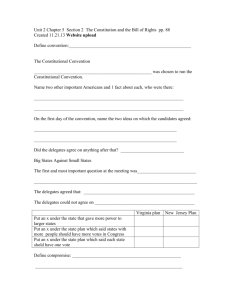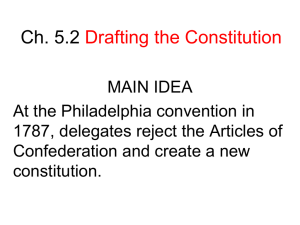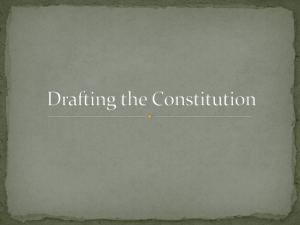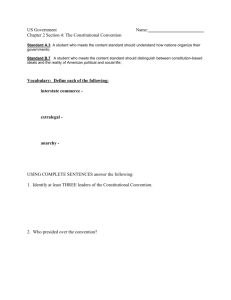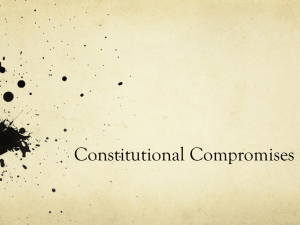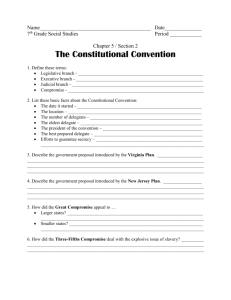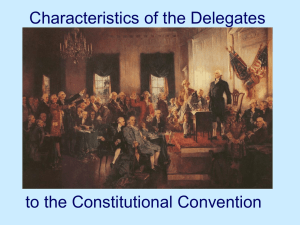Drafting the Constitution Note Sheet
advertisement
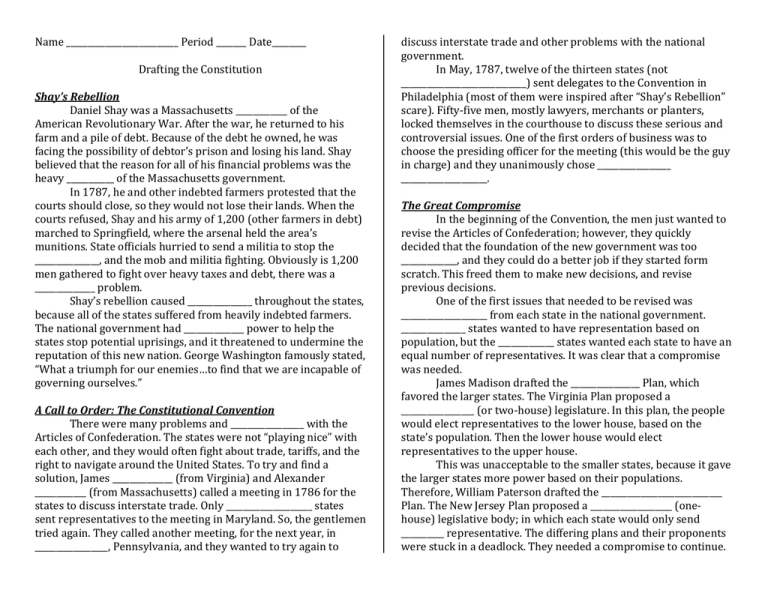
Name __________________________ Period _______ Date________ Drafting the Constitution Shay’s Rebellion Daniel Shay was a Massachusetts ____________ of the American Revolutionary War. After the war, he returned to his farm and a pile of debt. Because of the debt he owned, he was facing the possibility of debtor’s prison and losing his land. Shay believed that the reason for all of his financial problems was the heavy ___________ of the Massachusetts government. In 1787, he and other indebted farmers protested that the courts should close, so they would not lose their lands. When the courts refused, Shay and his army of 1,200 (other farmers in debt) marched to Springfield, where the arsenal held the area’s munitions. State officials hurried to send a militia to stop the _______________, and the mob and militia fighting. Obviously is 1,200 men gathered to fight over heavy taxes and debt, there was a ______________ problem. Shay’s rebellion caused _______________ throughout the states, because all of the states suffered from heavily indebted farmers. The national government had ______________ power to help the states stop potential uprisings, and it threatened to undermine the reputation of this new nation. George Washington famously stated, “What a triumph for our enemies…to find that we are incapable of governing ourselves.” A Call to Order: The Constitutional Convention There were many problems and _________________ with the Articles of Confederation. The states were not “playing nice” with each other, and they would often fight about trade, tariffs, and the right to navigate around the United States. To try and find a solution, James ______________ (from Virginia) and Alexander ____________ (from Massachusetts) called a meeting in 1786 for the states to discuss interstate trade. Only ____________________ states sent representatives to the meeting in Maryland. So, the gentlemen tried again. They called another meeting, for the next year, in _________________, Pennsylvania, and they wanted to try again to discuss interstate trade and other problems with the national government. In May, 1787, twelve of the thirteen states (not _____________________________) sent delegates to the Convention in Philadelphia (most of them were inspired after “Shay’s Rebellion” scare). Fifty-five men, mostly lawyers, merchants or planters, locked themselves in the courthouse to discuss these serious and controversial issues. One of the first orders of business was to choose the presiding officer for the meeting (this would be the guy in charge) and they unanimously chose _________________ ____________________. The Great Compromise In the beginning of the Convention, the men just wanted to revise the Articles of Confederation; however, they quickly decided that the foundation of the new government was too _____________, and they could do a better job if they started form scratch. This freed them to make new decisions, and revise previous decisions. One of the first issues that needed to be revised was ____________________ from each state in the national government. _______________ states wanted to have representation based on population, but the _____________ states wanted each state to have an equal number of representatives. It was clear that a compromise was needed. James Madison drafted the ________________ Plan, which favored the larger states. The Virginia Plan proposed a _________________ (or two-house) legislature. In this plan, the people would elect representatives to the lower house, based on the state’s population. Then the lower house would elect representatives to the upper house. This was unacceptable to the smaller states, because it gave the larger states more power based on their populations. Therefore, William Paterson drafted the ____________________________ Plan. The New Jersey Plan proposed a ___________________ (onehouse) legislative body; in which each state would only send __________ representative. The differing plans and their proponents were stuck in a deadlock. They needed a compromise to continue. Roger ______________ a delegate from Connecticut, offered a solution to the problem, and his suggestion took the name “The _________________ ___________________.” Sherman suggested that the congress should be a bicameral legislature. In the lower house (or the _____________ of ____________________), states would send representatives based on _________________; but in the upper house (or the ___________________), each state would send ________________ representatives each. The citizens of each state would elect the members to the House of Representatives, but the state legislature would choose the members of the members of the Senate. The compromise was acceptable to the two opposing sides, and this became the structure for the national _________________ branch. The Issue of Slaves and the Constitution When the delegates could agree on the Great Compromise, it created a new problem that needed a fair solution. If they were going to have a legislative house’s representation based on population, then they needed to know how to _______________ each state’s population. More importantly, who would be counted for the state’s population? Delegates from the southern states wanted to include their _________________ population. The delegates from the northern states believed this would give the South (who had more slaves than the North) an unfair advantage. The delegates agreed to the ___________ - ______________ Compromise, which allowed states to count only three-fifths of the state’s slave population. This agreement illuminates the country’s attitudes towards slaves, as it states that an African slave was worth only _______%, compared to a free, white man. Slavery was an important issue for the southern states. Their ______________ were based on the labor from these men and women. The delegates from these states were careful not to give the national government any power that would threaten the shipping or use of slaves. For example, the delegates to Philadelphia wanted to give Congress the right to ______________ foreign ____________ (remember, we marked that as a weakness of the Articles of Confederation). But the southern states worried that id they regulated foreign trade, then they might _______________ the slave trade. To come to a compromise, the southern states agreed to regulate interstate and foreign trade if the Congress promised not to interfere with the slave trade for at least _________ years. Not everyone was happy with this arrangement, but it was the only way to get the southern states to agree. Decision Time for the Delegates at the Constitutional Convention After all of the fighting and arguing had finished and compromises were made, it was time to create a new system of government of the United States of America. The delegates decided there would be a few concepts that would frame the government: __________________ government and ________________ of powers. Instead of a confederation, where all the power came from the individual states, this time the delegates wanted to form a ___________________. Federalism is a government in which the power is shared between the ______________ level and the _________________ government. The national government would be given the authority to control foreign affairs, provide national _________________, regulate _________________ between states, and coin __________________. Since these powers are specifically states in the Constitution, then these are called delegated or ____________ powers. Those powers that were kept at the state level are called ___________________ powers, which include providing and supervising ___________________, establishing _______________ laws, and regulated trade ________________ a state. However, both the national and state levels of government would have the power to _________________, or borrow money, and to pay debts. Since the delegates feared a tyrant or abusive national leader, they wanted to separate the power within the national government by establishing three different ________________ within the government, and providing a way for the different branches to “police” each other. The first branch listed in the Constitution is the __________ branch, which is responsible for making the national laws. The second branch listed is the ________________ branch, which is responsible for enforcing (carrying out) the national laws. The third branch listed is the _____________ branch, which is responsible for the interpreting (judging) the meaning of the national laws. Then, delegates created a system of _____________ and _________________. This system would prevent once branch from becoming more powerful than the others. Look at the chart below to see how each branch prevented abused by the other two. Electing the President of the United States of America At the _______________ ____________________, the delegates worried that in these early stages of the national government, the people of the United States were unable to effectively vote for the ___________________. First, they worried about communicating the important principles of each candidate, so each voter could make a fair and honest choice. Second, they were concerned that there were no political parties to help guide the decision of voters and the opinion of candidates. Third, many of the upper class Americans did not trust the lower class Americans to make a wise choice with their vote. To smooth these concerns, the delegates created the _____________ ________________. Instead of each person voting, and that vote being tallied in a popular election (the man with the most votes wins), the Electoral College would vote for the general population. In this scenario, each state would choose a number of __________________ (equal to the total number of representatives and senators in Congress from each state), and those electors would cast their vote for the presidential candidate. The Constitution of the United States of America Once all the delegates, arguments and compromises were completed, the Constitutional Convention adjourned on _______________, 1787. Now, it was up to the states to decide if this was an effective and fair form of government. Each state legislature was sent a copy of the highly debated and compromised document, and it was ____________________ turn to debate the big ideas of government. The country waited anxiously while each of the thirteen colonies decided whether or not to submit their _________________.

